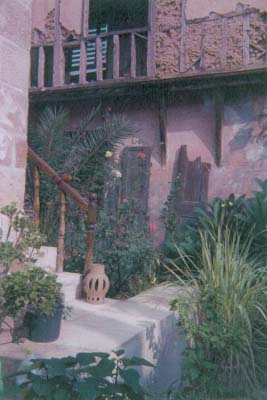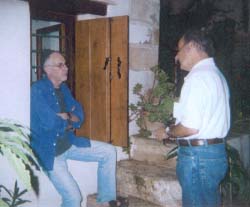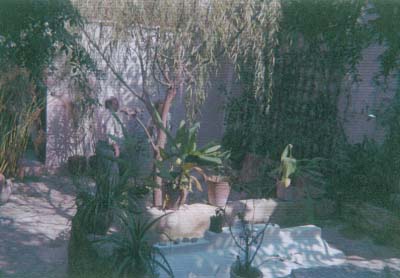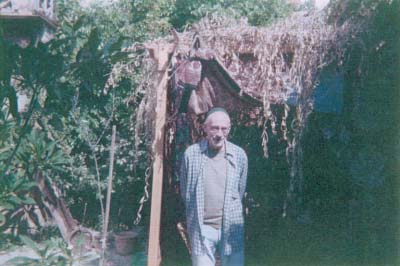HANIA, CRETE-- As recently as six years ago, the synagogue of Etz Hayyim ("The Tree of Life") was little more than a pile of rubble and junk--the
result of the Nazi occupation of Crete in 1941 which not only destroyed the synagogue but the entire Jewish population of the city, some three hundred souls.
Despite the synagogue's
long history--originally a Greek Orthodox church, it was ceded to the
Jewish community in the 17th century by the Ottomans--and its symbolic
importance, there were those in the worldwide Jewish community who felt
it should be left as is, a monument to the Holocaust.

Not Nicholas Hannan-Stavroulakis, though. Once the head of the Jewish
Museum in Athens (and a noted scholar and teacher), he felt that it was
important to not only rebuild the synagogue but to turn it into a functioning
house of worship and repose. Stavroulakis, whose father came from Hania,
gave up his job in Athens and moved to Crete, where he singlehandedly
launched his mission to help bring the synagogue back from the grave.
"Jews have been
associated with Crete since antique times," said
Stavroulakis. "They were first mentioned in Maccabees and probably
came
to the island from Alexandria, where they were artisans and technicians.
At one time, there were as many as eight synagogues on the island. I could
not allow the number to be reduced to zero."

Thanks to contributions from the World Monuments Fund in New York, the
Central Board of Jewish Communities in Greece, and from private donors,
funds were found to reconstruct the synagogue, a small, shapely structure
which sits behind high walls on a side street, not far from the harbor,
in Hania's Old Town. It is the oldest surviving synagogue in Greece (along
with that of Rhodes).
The interior layout
is common to Romaniote synagogues of Greece. (The
term Romaniote refers to those Jews who trace their origin back to the
Greco-Roman period or to Byzantine Jewries). The Ark is located against
the east wall, with the Pulpit located axially opposed to it on the west
wall. The seating arrangement allows the participants to face each other
on either side of the central nave. The synagogue contains two Sepher
Torahs (Scrolls of the Law), one from a synagogue in Cairo, the other
from an abandoned synagogue in Prague.

There is also an adjoining mikveh (ritual bath), offices, and two pebbled
courtyards, one of which contains four sacred graves, the other of which
is resplendent with flowers, vines and trees. Here Stavroulakis has also
built a simple but inviting hut which serves as a sanctuary for visitors.
"My idea has always been to open Etz Hayyim's doors to all denominations--Christian, Muslim and Buddhist as well as Jewish. I want this place to be not just a synagogue but a welcoming, all- embracing center where people of various religious beliefs can come together in the spirit of Havurah--a confraternity of friends," Stavroulakis explained.
The joining together of people to share and explore universal values and beliefs comes naturally to Stavroulakis, who was born in England to Jewish parents but spent the war years in the USA, first attending a Catholic boarding school and then Notre Dame, where he studied art. Later he took Mortimer Adler's Great Books course and, in his words, "became a Gandhi freak." This led to further art studies in India which he later combined with Middle East research.
The latter interest
took him to London University, where he worked on a
doctorate in Islamic Studies. Byzantine iconography became another
fascination, which he retains to this day. Teaching stints followed but
he eventually tired of academia and went to Turkey (his mother's birthplace),
a country which he loved but found "too raw." Returning to Athens,
he took up a teaching job at the British Army School, which later became
a private American high school.
Israel was the next stop on his restless, peripatetic journey, where he lived off his painting, woodcuts and teaching gigs at Tel Aviv University. He loved Israel, but left in protest after the Six Day War when it became clear that, in its drive to expand, Israel would not give the West Bank back to the Arabs. That motivated his return to Athens and, in 1977, led to the job at the Jewish Museum.
Stavroulakis was a lot of things when he came to Hania in 1994-- a scholar, artist, administrator and teacher. One thing he definitely was not was a rabbi. In fact, he was more interested in Buddhism than Judaism at the time, except of course for his deep- rooted determination to keep the memory of the lost Jewish community of Hania alive.
"I got a wake-up
call from the chief rabbi who came from Thessaloniki to consecrate Etz
Hayyim when the reconstruction work was completed," he
recalled. "'What do you want this building to be?' he asked. 'If
you want it to be a synagogue you must pray.'"
So Stavroulakis started
praying. Put another way, he was obliged to
rediscover his Jewish faith. "I became religious again, not in the
formal sense, but religious nonetheless."

He also had to find a way to begin holding services in the synagogue.
Thanks to Hitler, there were no Cretan Jews left in Hania. But he did
find six Israelis who were working on the island and who, combined with
the handful of Jewish tourists who found their way to the synagogue, could
make for a minyan (quorum). In lieu of a rabbi, Stavroulakis (helped by
the others) would lead the ceremony. When the High Holidays came, though,
sophisticated leadership was needed. Stavroulakis appealed for help over
the Internet, resulting in the arrival from abroad of not one but three
different rabbis, one Orthodox, the other Conservative, the third Reform.
"They started arguing over which form the service should take," Stavroulakis said. "When they couldn't agree on anything, I led them to a side room and closed the door. 'I don't care what kind of Jews you are,' I told them, 'but either you work things out or I'll keep you locked up all night.' Guess what--in less than an hour they found a way to compromise."
In keeping with his tolerant and eucumenical views, Stavroulakis does not segregate the women who come to the synagogue. Not only that, they are counted as part of the minyan.
"Exclusion by
gender, sexual orientation and manner of observance is
erroneous," he believes. "Women, homosexuals and lesbians and
Jews of
different observances at different levels, or even none at all, all bring
rich experiences to our search for wholeness."
Thanks to Stavroulakis'
beliefs and openness, Etz Hayyim Synagogue has
begun to attract large numbers of visitors on a regular basis. Stavroulakis
has also formed a "Friends of Etz Hayyim" society whose donations
have enabled him to open a reference library with works on Judaism, Jewish
History and Spirituality. He is also in the process of building up a similar
section on Christianity and Islam.
The Tree of Life has not only been revived, it is spreading its branches and blossoming.
(All visitors are welcomed at Etz Hayyim. There are two annual celebrations at which people of various religious traditions interact: Pesah, the Feast of Freedom; and Sukkoth, the Festival of Thanksgiving. Friends of the Etz Hayyim Synagogue, POB 251, Hania, Crete, Greece 73100. Tel. 30- 821-86286 or click on www.etz-hayyim-hania.org)